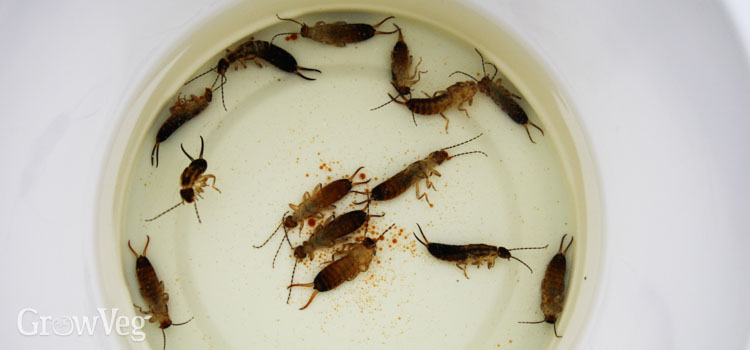How To Catch Earwigs In The Garden
Dealing with Earwigs in your Vegetable Garden

Like most gardeners, I first became acquainted with earwigs (Forficula auricularia) when I moved a big clay pot and saw them scurry away from their snug spot beneath it. They were not a problem that year, or in many seasons since, but this year is different. Last week they ate a flat of cosmos seedlings and chewed several herbs I had growing on the deck, and my first head of cabbage had a gang of earwigs hiding in the outer leaves.
I'm reluctant to engage in direct earwig control because they are not always harmful. While earwigs do eat leaves and fruits from a long list of plants, they also consume small soft-bodied insects. But especially in rainy years, earwigs in the garden become so numerous that they turn up everywhere and eat things you wish they wouldn't, like the poor basil below. Evidence of earwig feeding includes leaves with holes that have ragged edges, or are only partially rasped through, and a light scattering of very small black particles of earwig excrement.

The Earwig Ick Factor
Some people are unreasonably icked out by earwigs, in part because they look so threatening. In fact, gardeners who take snakes and spiders in stride are sometimes fearful of earwigs. Originally from Europe, the common earwig has spread to temperate climates throughout the world.
Personally, you have nothing to fear from earwigs. The pincers on their hind ends are used for mating, not biting, and they don't get into people's ears. Emergency room records indicate that another insect (rhymes with coach) is the bad one. And consider: earwigs in the garden inhabit the moist, dark world of plants and pots and mulch outdoors, and should they come indoors at all it would be to set up housekeeping in a basement rather than a bedroom. In her book, The Earwig's Tale, writer May Berenbaum notes that "the reluctance of earwigs to fly would seem to reduce the probability of their gaining access to the ears of anyone who doesn't habitually sleep with his head jammed into basement corners."

Efficient Earwig Traps
Wherever they are, earwigs are easy to trap in homemade traps as long as you choose the right method for the job. Earwigs feed at night and gather in sheltered places during the day, so most earwig traps use attractive habitat, or refuge, as their lure.
The exception is the oil pit trap, developed by entomologist Whitney Cranshaw. The best earwig trap to use in the open garden, an oil pit trap is simply a small plastic container with lid, with an entry hole cut in the lid. When baited with canola or olive oil, with a little bacon grease, fish oil or soy sauce sprinkled in for aroma, and sunk into the garden so the lid is flush with the surface, one of these earwig traps can clean up a cabbage patch fast. You won't catch innocent victims, because earwigs are the only garden creatures attracted to the traps, which will need to be emptied and refilled every week or so.

Another good way to trap earwigs in the garden is to roll lightly dampened newspapers into hollow tubes, tie them with thread or lightweight cotton string, and place them among plants that are under attack by earwigs. After a few days the earwigs will set up housekeeping in the newspaper tubes, which can be gathered up and composted. Short pieces of hollow bamboo the thickness of your finger can be used in the same way.
A similar reusable earwig trap can be made by placing plastic drinking straws inside a piece of plastic pipe. Earwigs seem to like plastic though it provides no purchase for their little feet. A couple of taps into a bowl of soapy water, and the earwigs come tumbling out of a drinking straw trap.
Earwigs can become persistent pests of peaches and other tree fruits, in which case cardboard earwig traps tied to trunks and lateral branches are in order. But you don't want to catch all of the earwigs, or at least not until late summer. Until then, research from Utah State University shows that earwigs do more good than harm by eating aphids and other small insects. But when fruits start to soften with ripeness, earwigs can become a problem.

To trap them, all you will need is some corrugated cardboard and strips of cloth to tie the traps to branches. Scientists use one-sided corrugated cardboard, which you can make by wetting one side of a piece of corrugated cardboard, and then prying it off. Make into a small roll, and fasten to trunks and major limbs. Install earwig traps a month before the fruit is expected to ripen, and replace once a week.
As for me, after this year's losses, I will take more care to disinvite earwigs to the area where I grow my seedlings. Earwigs stick together in groups, and I found the ones that were eating my seedlings hiding in the dry crevices between plastic pots and the trays used to hold them. It was a perfect set-up for them – rest under the moist pots during the day, come out and eat tender young leaves at night with no aggravation from frogs and other predators. Oops, my mistake.
By Barbara Pleasant
< All Guides
How To Catch Earwigs In The Garden
Source: https://www.growveg.com/guides/dealing-with-earwigs-in-your-vegetable-garden/
Posted by: caldwellhanceseles.blogspot.com

0 Response to "How To Catch Earwigs In The Garden"
Post a Comment